![]()
![]()
![]()
Use LEFT and RIGHT arrow keys to navigate between flashcards;
Use UP and DOWN arrow keys to flip the card;
H to show hint;
A reads text to speech;
47 Cards in this Set
- Front
- Back
|
Adrenergic Agonists/Catecholamine pharmacophore |
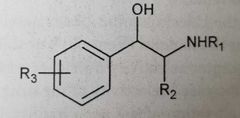
Primary or secondary amine 2 carbons away from substituted benzene ring.
Ethylamine chain essential to adrenergic activity
Ex: epinephrine, norepinephrine |
|

|
Norepinephrine (sympathomimetics, nonselective adrenergic agonist) Catechol group prone to oxidation
Alertness, increase heart rate and blood pressure, reduces blood flow to gastrointestinal system , releases glucose from energy stores |
|
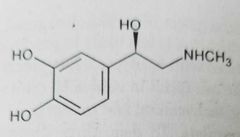
|
Epinephrine (sympathomimetics, nonselective adrenergic agonist)
Used to treat cardiac arrest and hypotensive crisis. Vasoconstrictor, ionotropic (increase contractility)/chronotropic (increase heart rate) |
|
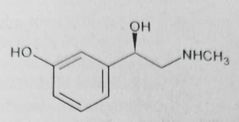
|
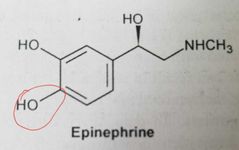
Phenylephrine (sympathomimetics, selective α-adrenergic agonist) Removal of para hydroxyl group increases α-receptor activity
Nasal decongestant. Maintain systemic blood pressure in hypotensive conditions
|
|
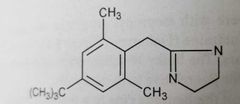
|
Oxymetazoline (sympathomimetics, selective α-adrenergic agonist)
Bulky para or meta substitution on benzene ring increases α activity
Nasal decongestant; vasoconstrictor in nasal mucosa |
|
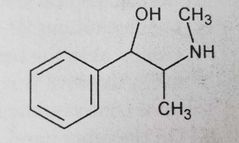
|
Pseudoephedrine (indirect sympathomimetics, α-agonist)
Removal of hydroxyls from catechol ring and addition of α-methyl group reduced direct receptor activity and increase indirect activity. Norepinephrine releasing Nasal decongestant |
|
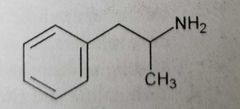
|
Amphetamine (indirect sympathomimetics) Removal of hydroxyls from catechol ring and addition of α-methyl group reduced direct receptor activity and increase indirect activity. Enhance catecholamine release in CNS. Used to treat ADHD |
|

|

Dobutamine (sympathomimetics, selective β-adrenergic agonist) Bulky N-substitution increases β-receptor selectivity Used in acute heart failure. Ionotropic via β1 receptors - open calcium channels (enhanced contractility) |
|

|

Albuterol (sympathomimetics, selective β-adrenergic agonist) Bulky N-substitution increases β-receptor selectivity
Alteration of meta hydroxyl group increases β2 selectivity over β1
Bronchodilator (activate β2 receptors)
|
|

|
Bethanecol Selective muscarinic agonist used to treat postoperative urinary retention and abdominal distention |
|

|
Neostigmine Reversible acetylcholine esterase inhibitor used to treat abdominal distention, urinary retention, and myasthenia gravis |
|
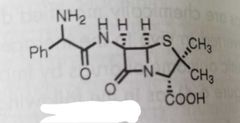
|
Ampicillin |
|
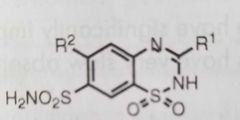
|
Benzothiazide
Thiazide diuretics |
|

|
Succinylcholine chloride Nicotine antagonist used as depolarizing neuromuscular blocking agent |
|
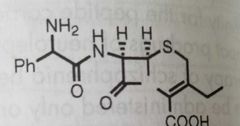
|
Cephalexin (cephalosporin antibiotic) |
|
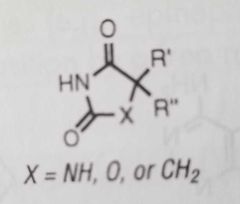
|
Antiepileptic agents Ex- phenytoin (X=NH) |
|

|
Propranolol
Nonselective β2 adrenergic antagonist
Used to treat hypertension and arrhymias (Substitution para to phenoxy position increase β1 selectivity) |
|
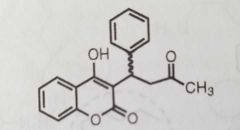
|
Warfarin Oral anticoagulant |
|
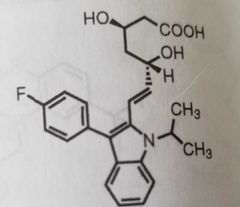
|
Fluvastatin Statin used to treat hypercholesterolemia |
|

|
Chlorpropamide Used to treat diabetes |
|
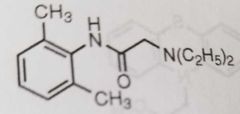
|
Lidocaine Local anesthetic |
|
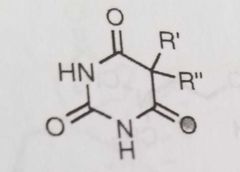
|
Barbiturates Sedative hypnotics, antiepileptics, anesthetics |
|

|
Pioglitazone Glitazone antidiabetic agent |
|
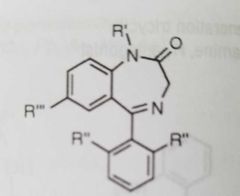
|
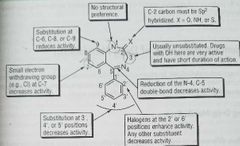
1,4-Benzodiazepines
Anxiolytics, antiepileptics, muscle relaxants |
|
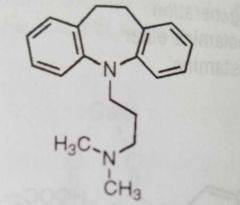
|
Imipramine Antidepressant |
|
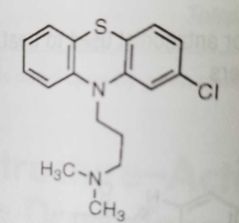
|
Chlorpromazine Antipsychotic agent |
|
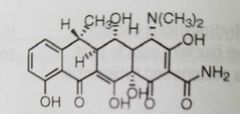
|
Doxycycline Antimicrobial agent |
|

|
Amprenavir Antiviral and HIV protease inhibitor |
|

|
Phenylisopropylamines CNS stimulants (ex- amphetamine) |
|

|
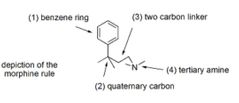
Morphine
Opioid receptor agonist Nearly all opioids and opiates have the morphine pharmacophore (above) |
|
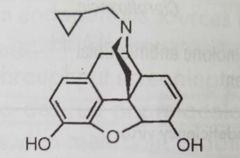
|
Naltrexone Opioid receptor antagonist |
|
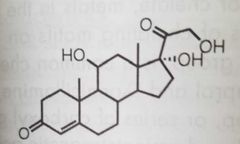
|
Hydrocortisone Adrenocorticoid |
|
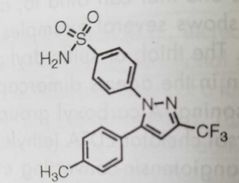
|
Celecoxib Selective COX-2 inhibitor |
|
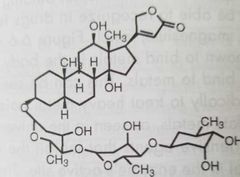
|
Digoxin Cardiac glycoside |
|

|
Diphenhydramine 1st gen ethanolamine ether antihistamine |
|
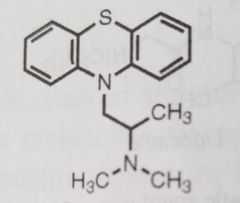
|
Promethazine 1st gen tricyclic antihistamine, H1 antagonist |
|
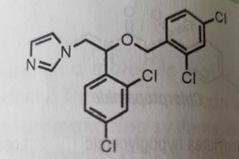
|
Miconazole Imidazole antifungal |
|

|
Cetirizine 2nd gen nonsedating H1 antihistamine |
|
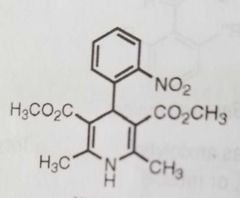
|
Nifedipine Calcium channel blocker used to treat angina pectoris and hypertension |
|

|
Famotidine H2 receptor antagonist used to treat peptic ulcers |
|
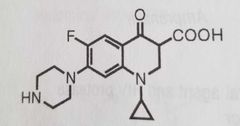
|
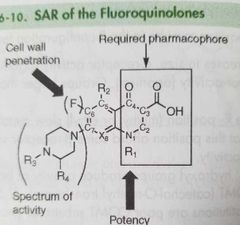
Ciprofloxacin
Quinolone antimicrobial Fluoroquinolones structure above: - c7 substituent: heterocyclic for gram neg activity. N for oral activity -x8 : N increases bioavailability; methoxy group increases stability to uv light -R1 and R2 groups affect gram pos potency |
|
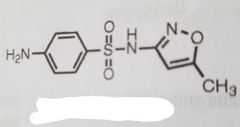
|
Sulfamethoxazole
Sulfonamide antimicrobial |
|
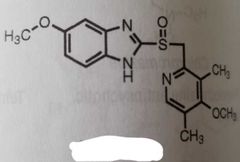
|
Omeprazole H+/K+ ATPase proton pump inhibitor used to treat peptic ulcers |
|

|
Sulfonamides with antimicrobial activity Acidity of sulfonamide group key to activity. Electron withdrawing R' group (ie- heteroaromatic ring) improves activity by enhancing acidity |
|

|
Sulfonamides with antidiabetic activity X= O, S, or N |
|
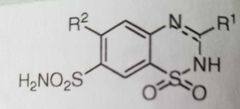
|
Sulfonamides with diuretic activity (Thiazide diuretics) Ex- hydrochlorothiazide |
|
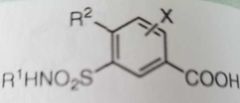
|
Sulfonamides with diuretic activity (high ceiling diuretics) Ex-furosemide |

